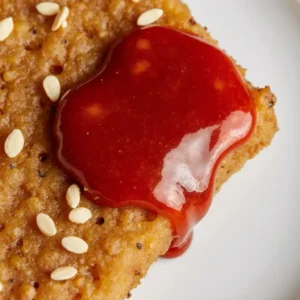Game night needed something sticky, sweet‑spicy, and impossible to stop eating, so a batch of gochujang chicken became the go‑to for glossy, lacquered bites that deliver heat, umami, and fast cleanup in under 30 minutes.
This gochujang chicken uses Korea’s iconic fermented chili paste to build layered depth and natural cling, so the glaze sets shiny without feeling heavy or overly sweet.
To finish confidently every time, confirm the thickest piece reaches 165°F with a thermometer before tossing in the final glaze for gochujang chicken and serving hot; see federal safety guidance at FoodSafety.gov.
For balance and easy tuning, learn how to adjust sweet‑heat‑tang in the Gochujang Sauce Guide, and consider a drizzle of Hot Honey at the table to dial sweetness for different palates.
Why this works
Thick fermented paste plus a quick reduction equals a tacky, high‑gloss finish that clings to crisped edges, so each bite hits sweet, savory, and spicy without sliding off.
Air fryer heat or a ripping‑hot skillet drives off surface moisture quickly to crisp the exterior before the glaze goes on, preserving juiciness inside.
Keeping part of the marinade separate (for glazing) avoids dull flavors from raw juices and creates a brighter, cleaner final coat.
Ending at 165°F locks in safety and consistency while preventing dry, stringy meat, especially on leaner cuts.
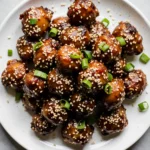
Sticky Gochujang Chicken
Equipment
- Mixing bowl
- whisk
- air fryer or oven
- skillet (for stovetop method)
- thermometer (for 165°F check)
- Tongs
Ingredients
- 1 lb boneless, skinless chicken thighs, cut into bite-size pieces
- 2 tbsp gochujang (Korean chili paste)
- 1 tbsp soy sauce or tamari
- 1 tbsp honey or brown sugar
- 1 tbsp rice vinegar
- 1 tsp toasted sesame oil
- 1 tsp fresh grated ginger
- 1 clove garlic, grated
- 1 tbsp neutral oil (for coating)
- 1 tbsp cornstarch
- 2 tbsp water (for thinning glaze)
- 1 tbsp scallions, sliced (for garnish)
- 1 tsp toasted sesame seeds (for garnish)
Instructions
- Whisk gochujang, soy sauce, honey, rice vinegar, sesame oil, ginger, and garlic until smooth. Reserve half for glazing.

- Toss chicken with cornstarch and neutral oil, then coat with half the sauce. Let marinate 5–10 minutes while preheating.
- Air fryer method: Preheat to 390°F. Arrange chicken in one layer and cook 8–10 minutes, shaking halfway for even color.
- Stovetop method: Heat 1–2 tbsp oil in a skillet. Sear chicken 4–5 minutes per side until crisp and nearly done.
- Oven method: Preheat to 425°F. Bake on parchment 10–12 minutes, then broil 1–2 minutes for charred edges.
- Simmer reserved sauce with water 1–2 minutes until glossy, toss hot chicken to coat, then rest 1 minute to set the glaze.
- Garnish with sesame seeds and scallions. Serve hot with rice, cucumbers, and kimchi for balance.
Notes
What is gochujang?
Gochujang is a traditional Korean fermented red chili paste made from chili powder, grains or starch (often rice), and fermented soybean components, producing savory‑sweet complexity with gentle heat; learn more from the Republic of Korea’s official portal at korea.net.
That fermentation creates natural sugars and umami that caramelize and shine when reduced briefly, making it ideal for fast weeknight glazes.
Because it is concentrated, balance it with soy (salt/umami), acid (rice vinegar or similar), and a touch of sweetener for a rounded sauce profile.
Ingredient notes
For the best gochujang chicken, choose boneless, skinless thighs for juiciness and tolerance to high heat, while breasts and wings adapt with minor timing changes.
Soy sauce adds salinity and umami; tamari or coconut aminos can substitute to preserve savory depth with less gluten exposure.
Honey creates shine, brown sugar adds caramel notes, and maple gives a smoother, rounder sweetness; rice vinegar maintains brightness without harshness.
Fresh garlic and ginger add warmth and backbone, a few drops of sesame oil bring toasty roundness, and a light cornstarch dust helps the reduction grip the surface.
Fast marinade (5 minutes)
Whisk 2 tbsp gochujang, 1 tbsp soy sauce, 1 tbsp honey, 1 tbsp rice vinegar, 1 tsp sesame oil, 1 tsp grated ginger, and 1 grated garlic clove until smooth and deeply aromatic.
Toss 1 lb bite‑size thigh pieces with 1 tbsp cornstarch and 1 tbsp neutral oil, coat with half the mixture, and reserve the rest for a clean glaze later.
This marinade sets up gochujang chicken for a tacky, shiny finish that coats evenly without pooling or turning sticky‑sweet.
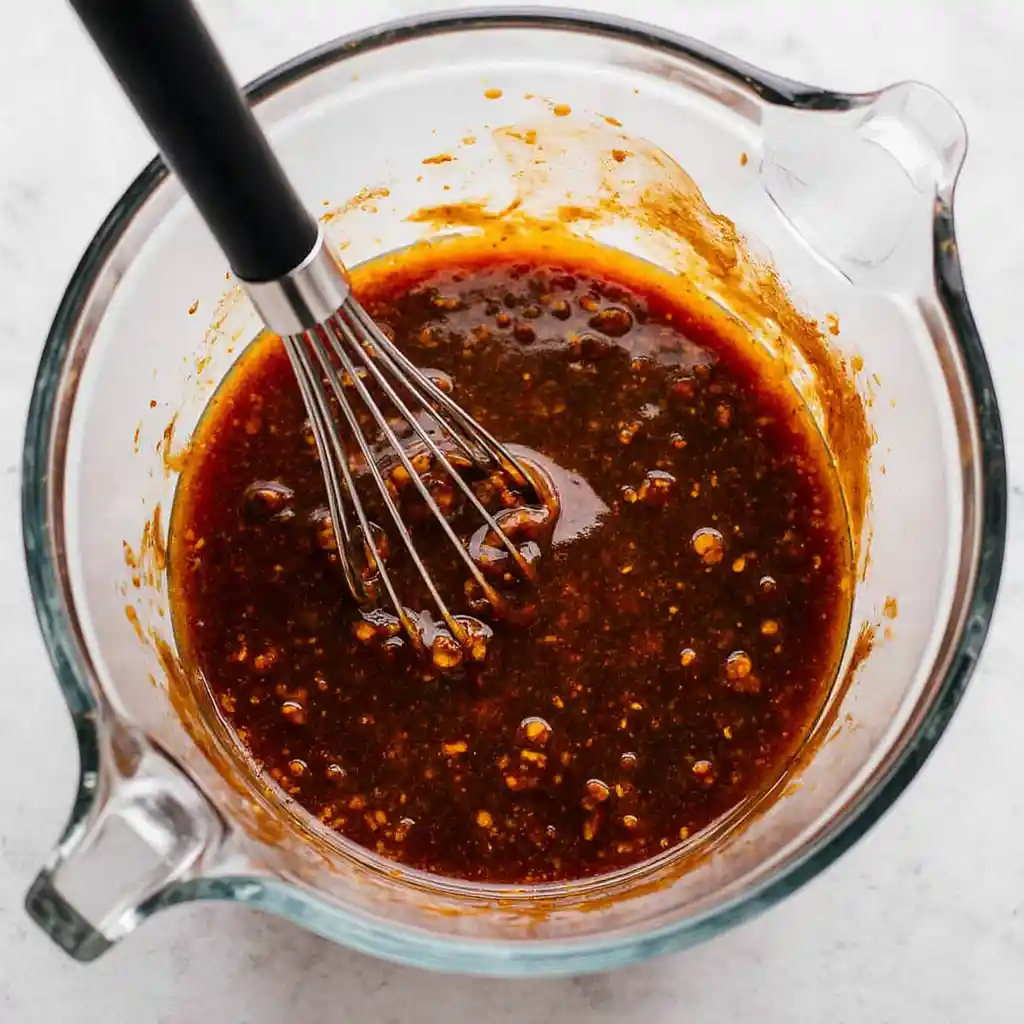
How to cook (three ways)
Air fryer gochujang chicken (fast and crispy)
Preheat to 390°F and lightly oil the basket to help release after browning; arrange pieces in one layer and cook 8–10 minutes, shaking once for even color.
Simmer the reserved mixture with 2 tbsp water for 1–2 minutes until glossy, toss the pieces to coat, then cook 1–2 minutes more to set the lacquer on gochujang chicken.
Garnish with sesame and scallions, then confirm the thickest piece reads 165°F before serving.
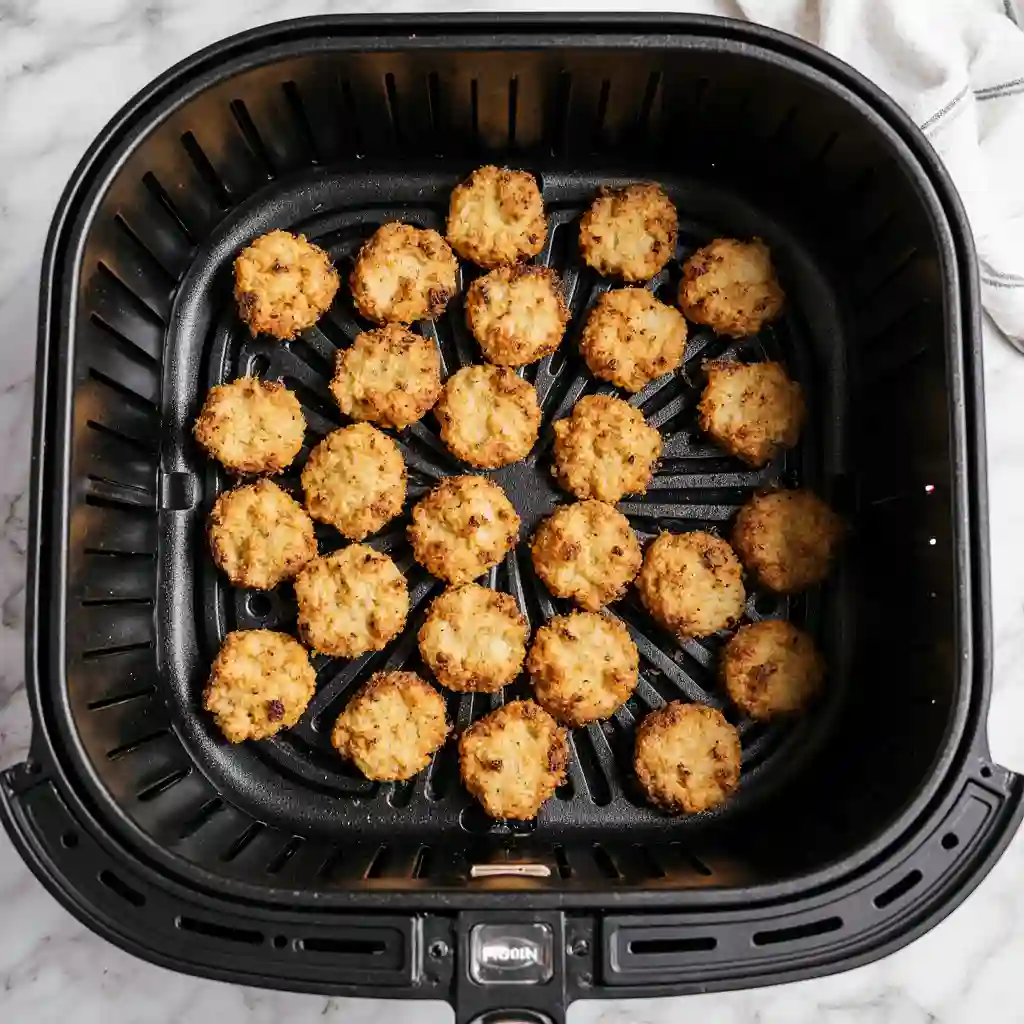
Stovetop gochujang chicken (deep sear and fond)
Heat a large skillet over medium‑high with 1–2 tbsp oil so edges color quickly without sticking; sear in a single layer 4–5 minutes per side until golden and nearly cooked.
Bubble the reserved mixture with a splash of water, toss to a high‑gloss coat, and verify 165°F in the thickest piece for safe, juicy gochujang chicken.
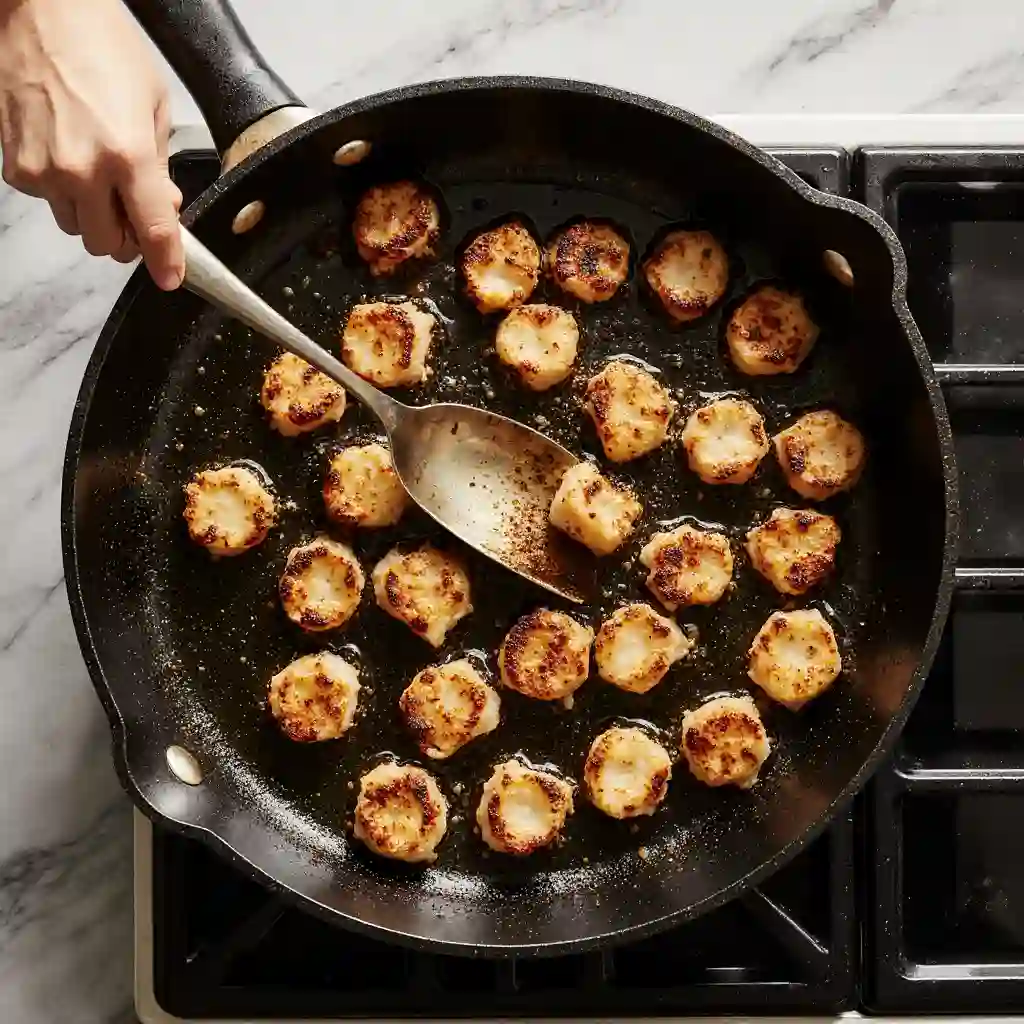
Oven‑baked gochujang chicken (hands‑off batch)
Preheat to 425°F, line a sheet pan with parchment, and lightly oil to encourage browning; bake 10–12 minutes, then broil 1–2 minutes to char edges without drying.
Warm the reserved glaze separately, toss, and confirm 165°F internal temperature before plating to keep gochujang chicken glossy and tender.
Sticky sauce ratio (copy‑worthy)
Use 2 parts gochujang, 1 part soy, 1 part sweetener, and 1 part acid with garlic and ginger to create a balanced, shiny reduction that clings instead of pooling for gochujang chicken.
Example: 2 tbsp gochujang, 1 tbsp soy, 1 tbsp honey, 1 tbsp rice vinegar, 1 tsp sesame oil, 1 clove garlic, 1 tsp ginger, plus 2 tbsp water; simmer 1–2 minutes until it coats a spoon.
The fermented base provides umami and body, while acid brightens and sugar helps the glaze set with a subtle sheen and clean finish.
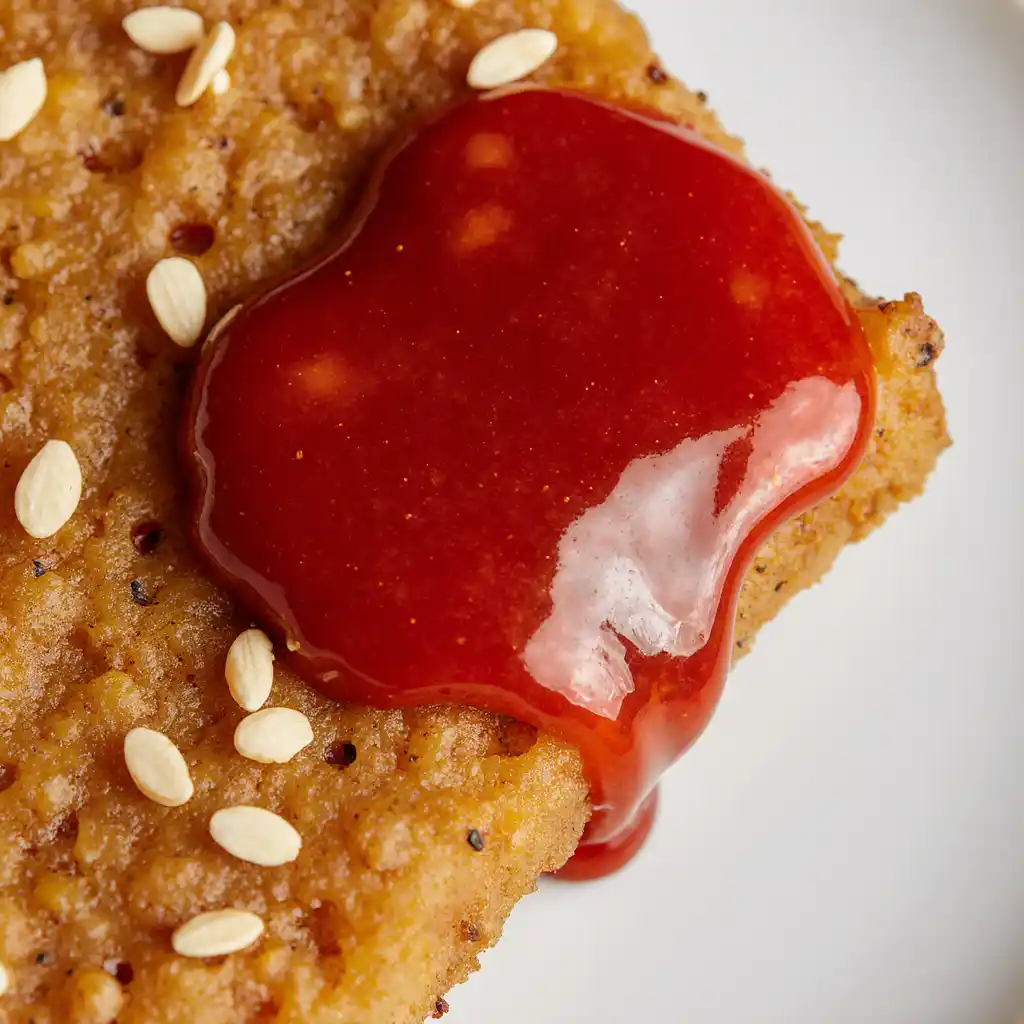
Method comparison (choose your path)
Air fryer is the fastest to crisp with minimal oil and an easy final pass to set the glaze; stovetop yields the deepest sear and fond in small batches; oven gives even doneness for larger trays with a quick broil to char edges before tossing.
For game night, the air fryer delivers back‑to‑back batches with consistent color, while the oven keeps things hands‑off so you can prep sides and garnishes simultaneously.
Batching and serving hot
Cook in batches and hold finished pieces on a wire rack over a sheet pan in a low oven so edges stay crisp while the next tray finishes, then glaze right before serving to keep gochujang chicken shiny.
Offer a squeeze bottle of Hot Honey and a small bowl of extra reduced sauce so guests can tune sweetness or stickiness on the spot without softening the coating prematurely.
Tuning heat, sweetness, and tang
Turn up the heat by adding a pinch of gochugaru or a tiny splash of chili oil to the simmered glaze for another layer of warmth, especially on gochujang chicken served with mild sides.
Soften the edge with more honey or maple for a rounder profile that still sets glossy after a brief simmer, or brighten the finish with a touch more rice vinegar or citrus.
Pro tips for consistent results
Pat pieces dry before tossing with cornstarch to encourage crisping instead of steaming, which helps the reduction adhere smoothly on gochujang chicken.
Reserve half the marinade for finishing to avoid dull, over‑reduced flavors from raw juices; reduce briefly, then toss off heat for a glassy shine.
Target 165°F in the thickest piece, rest briefly, and finish with the glaze to lock in juiciness and preserve the exterior’s snap.
For extra crunch with the air fryer, cook 6 minutes, rest 2, then another 3–4 minutes and glaze at the very end.
Variations and swaps
Honey glaze: Use honey as the sweetener and simmer 1–2 minutes for a candied sheen that stays tacky on the surface of gochujang chicken without clumping.
Wings: Bake or air fry naked for maximum crisp, then toss with a thickened reduction to avoid sogginess and keep the coating evenly distributed.
Breasts: Cut slightly larger to prevent overcooking; glaze gently right at the end for a soft, glossy coat over tender slices.
Gluten‑sensitive: Swap tamari for soy to preserve savory depth without the same gluten exposure.
Make‑ahead, storage, and reheating
Marinate 10–20 minutes for speed or up to 8–12 hours for deeper savor, always keeping a clean portion reserved for finishing so the glaze stays bright on gochujang chicken.
Cool and refrigerate promptly, then reheat in an air fryer at 360°F for a few minutes or in a skillet with a teaspoon of water to re‑gloss without drying.
Use a thermometer and reheat thoroughly until steaming hot throughout, especially after refrigeration, so texture and safety both check out.
What to serve with it
Serve with steamed rice, crisp pickled cucumbers, and kimchi for contrast and crunch that cuts the sticky‑sweet heat of gochujang chicken beautifully.
Load into lettuce cups with a spoon of rice and scallions for easy handheld bites on a party board.
Round out the spread with seafood like Anchovy Garlic Butter Salmon or a tray of Spicy Crispy Baked Chicken Thighs to hit different textures and heat levels.
FAQs
Can you marinate chicken in gochujang?
Yes the paste’s fermented sweetness, umami, and thickness deliver fast surface flavor; rest 10–20 minutes for speed or chill up to 8–12 hours for deeper savor before finishing with a clean reduction.
How to cook chicken with gochujang?
Air fry at 390°F ~8–10 minutes, stovetop‑sear ~8–10 minutes total, or oven‑bake at 425°F ~12–14 minutes, then toss in a simmered reduction and verify 165°F.
How do you make the sauce glossy without being too sweet?
Use a 2:1:1:1 balance of chili paste, soy, sweetener, and acid with garlic and ginger; simmer just until it coats a spoon, then toss off heat to keep the sheen bright.
What cuts work best and how do I keep them juicy?
Thighs are most forgiving; breasts work if cut slightly larger and glazed right at the end; always temp to 165°F and rest briefly before coating to prevent moisture loss.
Conclusion
This is a fast, glossy, sweet‑spicy crowd‑pleaser built on a balanced reduction and quick, high‑heat cooking, ready for a weeknight or scaled for parties without losing snap or shine.
Pick the method that fits your night air fryer for no‑fuss crisp, skillet for deep sear, or oven for big trays then finish with a bright simmered glaze, a thermometer check at 165°F, and fresh garnishes.
For cultural context on fermented staples and how they anchor this flavor profile, explore the Republic of Korea’s overview at korea.net, then tune sweetness or heat to taste at the table.

